
Scabiosa is a genus in the honeysuckle family (Caprifoliaceae) of flowering plants. Many of the species in this genus have common names that include the word scabious, but some plants commonly known as scabious are currently classified in related genera such as Knautia and Succisa; at least some of these were formerly placed in Scabiosa. Another common name for members of this genus is pincushion flowers.

Knautia is a genus of flowering plants in the family Caprifoliaceae. The common names are variants of "widow flower". Others are given the name "scabious", which properly belongs to the related genus (Scabiosa). The name Knautia comes from the 17th-century German botanists, Drs. Christoph and Christian Knaut.

Centaurea scabiosa, or greater knapweed, is a perennial plant of the genus Centaurea. It is native to Europe and bears purple flower heads.

Scabiosa graminifolia, grass-leaved scabious is a species of scabious found in the Mediterranean region. The plant grows on rocky slopes. As its name indicates, this species has grass-like leaves. Its flowers are pink or lilac and open in summer.
Great Cheverell Hill is a 33.2 hectare biological Site of Special Scientific Interest at Great Cheverell in Wiltshire, notified in 1971.

Scabiosa atropurpurea, the mourningbride, mournful widow, pincushion flower, or sweet scabious, is an ornamental plant of the genus Scabiosa in the family Caprifoliaceae. It is native to southern Europe.

Knautia arvensis, commonly known as field scabious, is a herbaceous perennial species of flowering plant in the honeysuckle family Caprifoliaceae.

Succisa pratensis, also known as devil's-bit or devil's-bit scabious, is a flowering plant in the honeysuckle family Caprifoliaceae. It differs from other similar species in that it has four-lobed flowers, whereas small scabious and field scabious have five lobes and hence it has been placed in a separate genus in the same family. It also grows on damper ground.
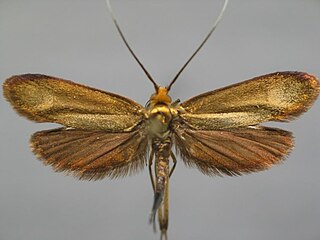
Nemophora metallica is a moth of the family Adelidae. It is found in Europe.

Stenoptilia bipunctidactyla, also known as the twin-spot plume is a moth of the Pterophoroidea family found in North Africa, Asia and Europe. It was first described by the Austrian physician and naturalist, Giovanni Antonio Scopoli in 1763. It is one of four similar looking moths.
Fishburn Grassland is a Site of Special Scientific Interest in the Sedgefield district of County Durham, England. It lies between the villages of Fishburn and Trimdon, just north of the former.
Quarrington Hill Grasslands is a Site of Special Scientific Interest in County Durham, England. The site consists of three separate areas, two closely adjacent to the east of the village of Quarrington Hill, the third immediately west of the village, which lies 8 km south-east of Durham City.
Tuthill Quarry is a Site of Special Scientific Interest in the County Durham district of north-east County Durham, England. It lies just over 1 km east of the village of Haswell.
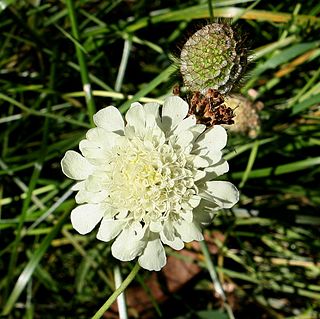
Scabiosa ochroleuca, commonly called cream pincushions or cream scabious, is a species of scabious with creamy yellow flower heads. It is native to Europe and western Asia.
Stenoptilia annadactyla, also known as the small scabious plume, is a moth of the family Pterophoridae. It was first described by Reinhard Sutter in 1988 and is found in Europe.
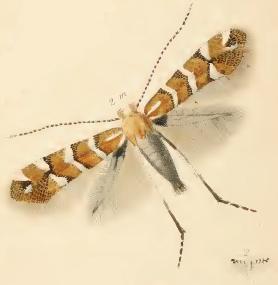
Phyllonorycter scabiosella is a moth of the family Gracillariidae. It is found from Great Britain through Germany, Poland and Ukraine to southern Russia and from the Netherlands to Spain and Italy.
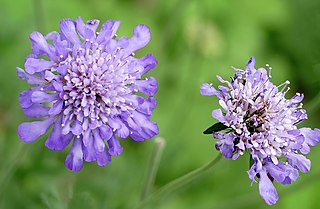
Scabiosa triandra is a species of scabious belonging to the family Caprifoliaceae.

Scabiosa columbaria, called the small scabious or dwarf pincushion flower, is a widespread species of flowering plant in the genus Scabiosa, native to Europe, Africa, and western Asia, from Sweden to Angola. In the garden it is a short-lived deciduous perennial. In the wild in Europe it prefers to grow in calcareous grasslands.
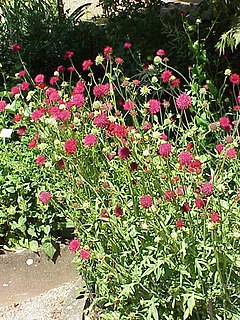
Knautia macedonica, the Macedonian scabious, is a species of flowering plant in the family Caprifoliaceae, native to Southeastern Europe - Albania, Bulgaria, Greece, North Macedonia, southeastern Romania and Kırklareli in Turkey. Growing to 75 cm (30 in), this herbaceous perennial produces rich red "pincushion" flowers, similar to those of its close relative scabious (Scabiosa), on slender upright stems throughout summer.
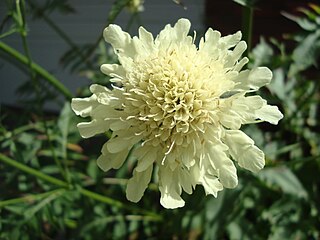
Cephalaria gigantea, the giant scabious or yellow scabious, is a species of flowering plant in the honeysuckle family Caprifoliaceae. It is native to the Caucasus and Turkey, but also cultivated as an ornamental.














